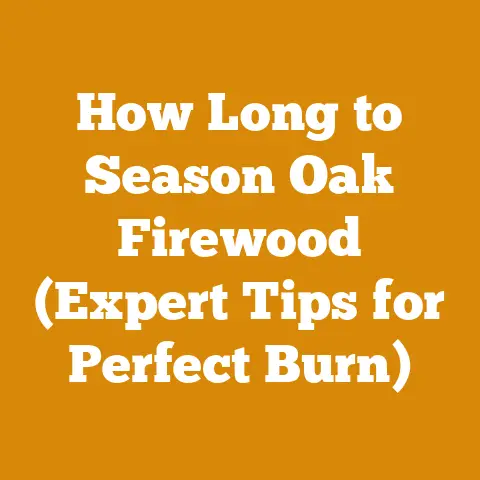Wood Stove Outside House: Is a Fan Forced Outdoor Furnace Worth It? (Heat Tech Insights)
Ah, the scent of woodsmoke on a crisp autumn evening.
It takes me back to my grandfather’s farm, where the wood stove was the heart of the home, radiating warmth and the promise of hearty meals.
But times have changed.
Now, instead of a stove inside, we’re talking about a wood stove outside the house – specifically, a fan-forced outdoor furnace.
Is it worth it?
That’s what we’re going to explore.
I’ve spent years in the wood processing and firewood preparation business, and I’ve seen firsthand what works and what doesn’t.
I’m excited to share my insights with you.
Wood Stove Outside House: Is a Fan Forced Outdoor Furnace Worth It? (Heat Tech Insights)
The question of whether a fan-forced outdoor furnace is worth the investment is a complex one.
It depends on various factors, including your heating needs, budget, location, and commitment to wood as a fuel source.
I will break down all the aspects of this system to help you make an informed decision.
Understanding the Basics: Key Terms and Concepts
Before we delve into the specifics, let’s define some key terms:
- Green Wood: Freshly cut wood with a high moisture content (often 50% or higher).
Green wood is difficult to burn efficiently and produces a lot of smoke. - Seasoned Wood: Wood that has been allowed to dry, reducing its moisture content to 20% or less.
Seasoned wood burns cleaner, hotter, and more efficiently. - BTU (British Thermal Unit): A unit of energy.
It’s the amount of heat required to raise the temperature of one pound of water by one degree Fahrenheit.
We use BTU to measure the heating output of furnaces and stoves. - Outdoor Wood Furnace (OWF): A wood-burning furnace located outside the building it’s heating.
It heats water, which is then circulated to the building through insulated underground pipes. - Fan-Forced: Refers to a furnace that uses a fan to force air over the firebox, increasing combustion efficiency and heat output.
- Firebox: The chamber within the furnace where the wood is burned.
- Water Jacket: The area surrounding the firebox that contains water, which is heated by the combustion process.
- Heat Exchanger: A device that transfers heat from one fluid (in this case, hot water) to another (usually air or water in your existing heating system).
Why Consider an Outdoor Wood Furnace? The Allure and the Advantages
There are several reasons why someone might consider an outdoor wood furnace:
- Heating Large Spaces: OWFs are well-suited for heating large homes, shops, barns, or even multiple buildings.
- Reducing Indoor Mess: Wood-burning can be messy.
An OWF keeps the dirt, ash, and wood debris outside. - Supplemental Heat: Many people use OWFs to supplement their existing heating systems, reducing their reliance on expensive fossil fuels.
- Off-Grid Potential: In areas with readily available wood, an OWF can provide a significant degree of energy independence.
- Zone Heating: You can control temperatures in different zones of your home more easily with an OWF, especially if you have a hydronic heating system.
I remember one customer, a dairy farmer, who was struggling with high propane costs to heat his house and milking parlor.
After installing an OWF, he drastically reduced his propane consumption and was able to use wood harvested from his own property, saving him a considerable amount of money.
The Heart of the System: How a Fan-Forced Outdoor Wood Furnace Works
A fan-forced OWF isn’t just a glorified campfire in a box.
It’s an engineered system designed for efficient and controlled combustion.
Here’s the process:
- Combustion: Wood is loaded into the firebox and ignited.
The fan forces air into the firebox, providing oxygen for combustion. - Heat Transfer: The heat from the burning wood heats the water in the water jacket surrounding the firebox.
- Circulation: A pump circulates the hot water through insulated underground pipes to a heat exchanger inside the building being heated.
- Heat Exchange: The heat exchanger transfers the heat from the hot water to the air or water in the building’s existing heating system (e.g., forced-air furnace, radiant floor heating).
- Return: The cooled water is then returned to the OWF to be reheated.
The fan plays a crucial role in this process.
By forcing air into the firebox, it:
- Increases Combustion Efficiency: More complete combustion means more heat extracted from the wood and less smoke produced.
- Provides Better Temperature Control: The fan speed can be adjusted to regulate the fire’s intensity and maintain a consistent water temperature.
- Reduces Creosote Buildup: More complete combustion reduces the formation of creosote, a flammable substance that can accumulate in chimneys and pose a fire hazard.
Evaluating the Options: Types of Outdoor Wood Furnaces
Not all outdoor wood furnaces are created equal.
Here’s a look at the main types:
- Conventional (Non-Gasification): These are the simplest and often the least expensive OWFs.
They burn wood in a single-stage combustion process.
They tend to be less efficient and produce more smoke than gasification models. - Gasification: These furnaces use a two-stage combustion process.
In the first stage, the wood is heated to produce combustible gases.
In the second stage, these gases are burned at high temperatures, resulting in more complete combustion, higher efficiency, and lower emissions. - Forced-Air: Some OWFs directly heat air, which is then ducted into the building.
These are less common than hydronic models. - Hydronic: These are the most common type of OWF.
They heat water, which is then circulated to the building.
Fan-forced systems are typically found in both conventional and gasification models. The fan enhances the combustion process in both types of furnaces.
However, gasification models generally benefit more from fan-forced air because it helps ensure complete combustion of the gases produced.
Fan Forced Outdoor Furnace: A Deep Dive
As I said, the fan in a forced-air outdoor wood furnace is a game-changer.
Here’s why:
Advantages of Fan-Forced Systems:
- Increased Efficiency: The forced air allows for a more complete burn, extracting more heat from each piece of wood.
This translates to less wood consumption and lower heating costs.
I’ve seen efficiency improvements of 15-20% compared to non-fan-forced models. - Reduced Emissions: More complete combustion means fewer pollutants released into the atmosphere.
This is not only better for the environment but also can help you comply with local regulations. - Improved Temperature Control: The fan speed can be adjusted to fine-tune the fire’s intensity and maintain a consistent water temperature.
This is particularly important in climates with fluctuating temperatures. - Faster Heat-Up: The forced air helps the fire get going quickly, allowing the furnace to reach its operating temperature faster.
- Less Creosote Buildup: More complete combustion reduces the formation of creosote, minimizing the risk of chimney fires.
Disadvantages of Fan-Forced Systems:
- Electricity Dependence: Fan-forced OWFs require electricity to run the fan.
This means they won’t work during a power outage unless you have a backup generator. - Increased Complexity: The fan adds another component to the system that can potentially fail.
- Noise: The fan can generate some noise, although most modern models are relatively quiet.
- Higher Initial Cost: Fan-forced OWFs typically cost more than non-fan-forced models.
Fan Specifications and Considerations:
- CFM (Cubic Feet per Minute): This measures the amount of air the fan can move.
A higher CFM rating generally means better combustion efficiency.
Look for a fan with a CFM rating that is appropriate for the size of the firebox. - Voltage: Most OWF fans operate on 120V AC power.
- Variable Speed: Some fans have variable speed settings, allowing you to adjust the airflow based on the fire’s intensity and the desired water temperature.
- Durability: Choose a fan that is built to withstand the high temperatures and harsh conditions associated with outdoor wood furnaces.
The Nitty-Gritty: Installation, Maintenance, and Operation
Okay, let’s get practical.
Installing, maintaining, and operating an OWF isn’t rocket science, but it does require some knowledge and attention to detail.
Installation:
- Location: Choose a location that is at least 10-20 feet away from any buildings and downwind from your house (to minimize smoke exposure).
Ensure the location is level and has good drainage. - Foundation: The OWF needs to be placed on a solid, non-combustible foundation, such as a concrete pad.
- Piping: The insulated underground pipes connecting the OWF to your house must be properly installed to prevent heat loss and water damage.
Use high-quality, pre-insulated piping designed for underground burial. - Electrical Connection: A licensed electrician should handle the electrical connection for the OWF.
- Permits and Regulations: Check with your local authorities to ensure you have all the necessary permits and that your installation complies with local regulations.
Many areas have restrictions on OWF emissions and setback distances.
My Experience: I once helped a customer install an OWF, and he insisted on doing the underground piping himself to save money.
He used cheap, uninsulated pipe, and the heat loss was so significant that the system was barely able to heat his house.
He ended up having to redo the entire piping system with proper insulation, costing him more time and money in the long run.
Don’t cut corners on the piping!
Maintenance:
- Regular Cleaning: Clean the firebox and chimney regularly to remove ash and creosote.
The frequency of cleaning will depend on the type of wood you’re burning and the efficiency of your furnace. - Water Treatment: Maintain the proper water chemistry in the water jacket to prevent corrosion and scale buildup.
Follow the manufacturer’s recommendations for water treatment products. - Inspect and Replace Parts: Regularly inspect the fan, pump, and other components for wear and tear.
Replace parts as needed. - Check Insulation: Ensure the insulation on the OWF and the underground pipes is in good condition.
Repair or replace any damaged insulation. - Ash Removal: Remove ash regularly.
Ash can be used in gardens or composted (after cooling).
Operation:
- Use Seasoned Wood: This is the most important factor for efficient and clean burning.
Season your wood for at least six months, preferably a year or more. - Proper Loading: Load the firebox properly to ensure good airflow. Don’t overload it.
- Airflow Adjustment: Adjust the fan speed to maintain the desired water temperature and optimize combustion efficiency.
- Monitor Water Temperature: Keep an eye on the water temperature gauge to ensure the system is operating within the recommended range.
- Safety Precautions: Always follow the manufacturer’s safety guidelines.
Wear appropriate safety gear when handling wood and working around the furnace.
Wood Selection: The Fuel That Powers Your System
The type of wood you burn has a significant impact on the efficiency, emissions, and maintenance requirements of your OWF.
- Hardwoods vs.
Softwoods: Hardwoods (e.g., oak, maple, ash) are denser than softwoods (e.g., pine, fir, spruce) and contain more energy per volume.
Hardwoods burn longer and produce more heat.
Softwoods burn faster and produce more smoke. - Moisture Content: As mentioned earlier, seasoned wood is essential.
Green wood contains a lot of water, which must be evaporated before the wood can burn.
This process consumes energy and reduces the fire’s temperature. - Species Considerations: Some wood species are better than others for burning.
Oak, maple, and ash are excellent choices.
Avoid burning treated wood, painted wood, or wood containing nails or other metal.
My Wood Drying Setup: I’ve experimented with various wood drying methods.
I have found that stacking wood in a single row, off the ground on pallets, and covered with a tarp (leaving the sides open for airflow) is the most effective way to season wood in my climate.
I aim for a moisture content of 15-20% before burning.
I use a moisture meter to check the moisture content of the wood.
Firewood Preparation Tools and Techniques:
- Chainsaws: A good chainsaw is essential for cutting firewood.
I use a Stihl MS 261 C-M for most of my firewood cutting.
It’s powerful, reliable, and relatively lightweight.
Always wear appropriate safety gear, including a helmet, eye protection, hearing protection, and chaps. - Axes and Splitting Mauls: For splitting wood, I prefer a splitting maul for larger rounds and an axe for smaller pieces.
A good splitting technique is crucial for efficiency and safety. - Log Splitters: For large volumes of firewood, a hydraulic log splitter is a must-have.
I use a 27-ton gas-powered log splitter.
It significantly reduces the amount of time and effort required to split wood. - Wood Storage: Store your seasoned firewood in a dry, well-ventilated area.
Keep it off the ground to prevent moisture absorption.
Cost Analysis: Upfront and Ongoing Expenses
The cost of owning and operating an OWF includes both upfront and ongoing expenses.
Upfront Costs:
- Furnace Purchase: The cost of the OWF itself can range from \$5,000 to \$15,000 or more, depending on the size, features, and brand.
Fan-forced models typically cost more than non-fan-forced models. - Installation: Installation costs can vary depending on the complexity of the installation and whether you hire a professional or do it yourself.
Expect to pay several thousand dollars for professional installation. - Piping: The cost of the insulated underground piping can be significant, especially for long runs.
- Electrical Work: The cost of electrical work will depend on the complexity of the wiring and the electrician’s rates.
- Permits: Permit fees can vary depending on your location.
Ongoing Costs:
- Wood: The cost of wood will depend on whether you harvest it yourself or purchase it.
If you harvest it yourself, you’ll need to factor in the cost of equipment, fuel, and your time.
If you purchase it, the price will vary depending on the species, quantity, and location. - Electricity: The fan and pump require electricity to operate.
- Water Treatment: Water treatment products will need to be purchased periodically.
- Maintenance and Repairs: Budget for occasional maintenance and repairs.
- Insurance: Your homeowner’s insurance may increase if you install an OWF.
Case Study: Cost Savings Analysis
I worked with a customer who was heating his 2,500 square foot home with propane.
He was spending about \$3,000 per year on propane.
After installing an OWF, he was able to reduce his propane consumption by 80%.
He purchased wood for \$500 per year.
His total heating costs were reduced to \$1,100 per year, saving him \$1,900 per year.
Over the lifespan of the furnace (15-20 years), this could result in significant savings.
Safety First: Protecting Yourself and Your Property
Safety should always be your top priority when working with wood-burning appliances.
- Carbon Monoxide Detectors: Install carbon monoxide detectors inside your home to alert you to the presence of this deadly gas.
- Smoke Detectors: Ensure your smoke detectors are working properly.
- Fire Extinguishers: Keep fire extinguishers readily available near the OWF and inside your home.
- Chimney Cleaning: Regularly clean the chimney to prevent creosote buildup and chimney fires.
- Clearance to Combustibles: Maintain adequate clearance between the OWF and any combustible materials.
- Burn Permits: Obtain any necessary burn permits before operating the OWF.
- Follow Manufacturer’s Instructions: Always follow the manufacturer’s instructions for installation, operation, and maintenance.
- Protective Gear: Wear appropriate protective gear when handling wood and working around the furnace.
This includes gloves, eye protection, and hearing protection.
Environmental Considerations: Minimizing Your Impact
Wood-burning can have a negative impact on air quality if not done properly.
Here are some ways to minimize your environmental impact:
- Burn Seasoned Wood: This is the most important factor for reducing emissions.
- Use a High-Efficiency Furnace: Gasification furnaces are generally more efficient and produce fewer emissions than conventional furnaces.
- Properly Size Your Furnace: An oversized furnace will burn inefficiently and produce more smoke.
- Avoid Burning Trash or Treated Wood: These materials release harmful pollutants into the air.
- Comply with Local Regulations: Be aware of and comply with local regulations regarding wood-burning.
Is a Fan Forced Outdoor Furnace Right for You? A Decision-Making Framework
So, is a fan-forced outdoor furnace worth it?
Here’s a framework to help you decide:
- Assess Your Heating Needs: How large is the space you need to heat?
What is your current heating cost? - Evaluate Your Wood Supply: Do you have access to a reliable and affordable source of wood?
Can you harvest it yourself, or will you need to purchase it? - Consider Your Budget: Can you afford the upfront cost of the furnace and installation?
Can you afford the ongoing costs of wood, electricity, and maintenance? - Think About Your Time Commitment: Are you willing to spend the time and effort required to harvest, split, and stack wood?
Are you willing to perform regular maintenance on the furnace? - Research Local Regulations: Are there any restrictions on wood-burning in your area?
- Compare Different Models: Research different models of OWFs and compare their features, efficiency, and price.
- Get Professional Advice: Consult with a qualified HVAC professional or OWF dealer to get personalized advice.
Strategic Insights:
- Long-Term Savings: OWFs can offer significant long-term savings on heating costs, especially if you have access to a cheap or free source of wood.
- Energy Independence: OWFs can provide a degree of energy independence, reducing your reliance on fossil fuels.
- Environmental Benefits: If used properly, OWFs can be a relatively environmentally friendly heating option, especially compared to fossil fuels.
- Property Value: An OWF can increase the value of your property, especially in rural areas.
- Comfort and Convenience: OWFs can provide a comfortable and consistent source of heat, and they keep the mess of wood-burning outside your home.
Practical Next Steps: Getting Started with Your Wood-Burning Journey
If you’ve decided that a fan-forced outdoor furnace is right for you, here are some practical next steps:
- Research and Choose a Furnace: Research different models of OWFs and choose one that meets your needs and budget.
- Contact a Qualified Installer: Find a qualified HVAC professional or OWF dealer to install the furnace.
- Prepare Your Wood Supply: Start seasoning your wood well in advance of the heating season.
- Gather Your Tools: Purchase the necessary tools for firewood preparation, such as a chainsaw, axe, or log splitter.
- Learn About Safety: Educate yourself about the safety precautions associated with wood-burning.
- Obtain Permits: Obtain any necessary permits from your local authorities.
- Enjoy the Warmth! Once your OWF is installed and running, you can sit back and enjoy the warmth and comfort it provides.
Conclusion: A Warm and Sustainable Future
A fan-forced outdoor wood furnace can be a worthwhile investment for the right person and the right situation.
It offers the potential for significant cost savings, energy independence, and a connection to a traditional and sustainable heating source.
However, it’s important to carefully consider the costs, benefits, and responsibilities before making a decision.
I hope this guide has provided you with the information you need to make an informed choice and embark on your own wood-burning journey.
Remember, safety and sustainability should always be your top priorities.
Now, go forth, gather your wood, and stay warm!






